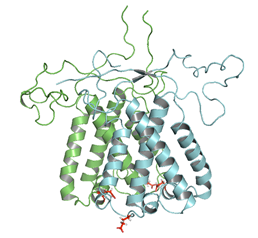A close view of a light-stress sensor in photosynthesis
Plants use sunlight to perform photosynthesis, but with too much light they have to dim their activity and protect their cells against photo damage. The protein PsbS acts as a light-stress sensor and plays a key role in this process. Article in Nature’s Scientific Reports.
Photo protection

Triggered by acidification of the plant chloroplast lumen -occurring under excess light conditions- PsbS gives a warning signal and prepares the photosynthetic antenna for photo protection. Reversibly, it speeds up the recovery from this process: boosting the levels of PsbS and two other proteins in bio-engineered Tobacco plants accelerated recovery from photo protection by which the plants produced 15-20% more biomass (Kromdijk et al., Science 2016, Vol. 354, pp. 857-861).
Structure-function
How PsbS operates is not clear. Until now, structure-function analyses of PsbS have been hampered by challenges to obtain the proteins in large quantities and retain them soluble in solution. Anjali Pandit and PhD-student Maithili Krishnan found ways to overcome these issues. With help from the LIC cloning facility, Krishnan developed novel methods to recombinant produce, purify and solubilize PsbS in high yields. Following, different spectroscopic techniques including NMR spectroscopy were combined to characterize PsbS at neutral and low pH.
A tunable pH sensor
For the first time they could demonstrate that lowering the pH actually changes the conformational dynamics of PsbS. Its activation mechanism is proposed to involve monomerization of PsbS dimers, but Krishnan and Pandit found that at both pH conditions the proteins are in monomer-dimer equilibrium. In low-pH solutions however, the equilibrium is shifted towards the monomer form. This observation suggests that PsbS’ pH-dependent activity might not be an “all-or-none” process, but could be tuned by the plants in a gradual manner.
The work, co-authored by Maithili Krishnan, Geri Moolenaar, Karthick Babu Sai Sankar Gupta, Nora Goosen and Anjali Pandit, is published online in Nature’s Scientific Reports.
